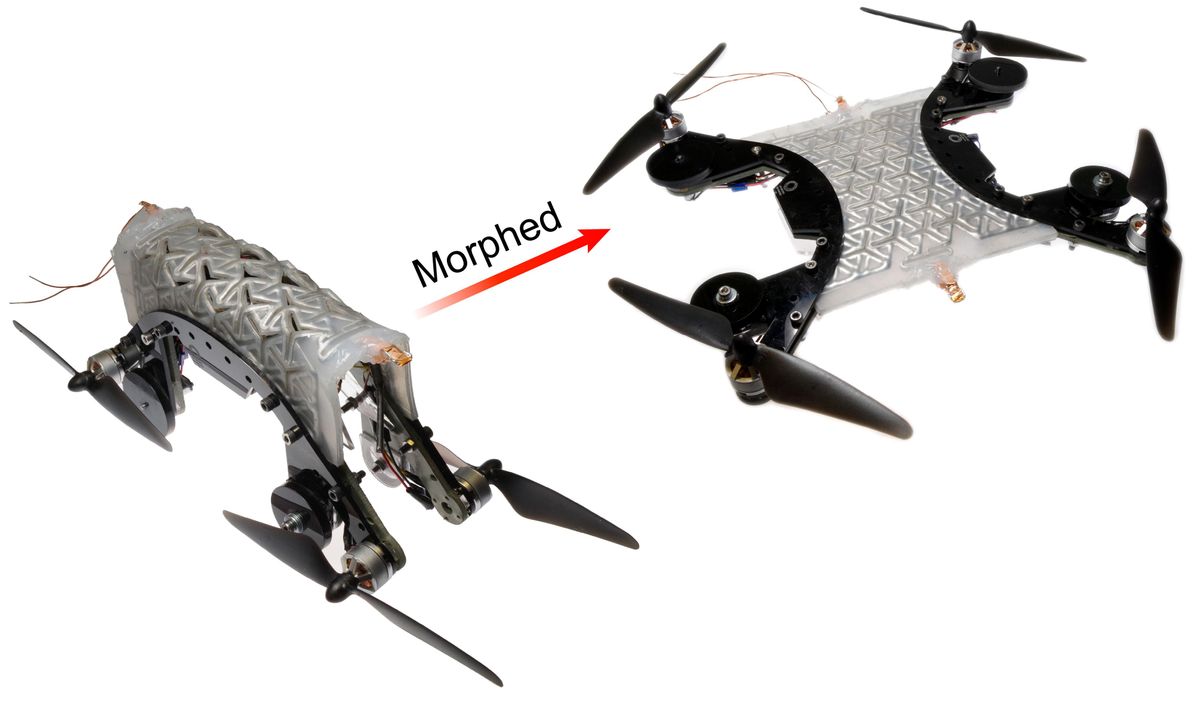Robots have all kinds of ways to change their shapes, in the sense that you can use rigid components along with actuators to design a robot that can go from one shape to another. Such a system is inevitably highly complex, though, and typically requires a lot of mass plus a lot of energy to switch to and then maintain the shape that you’d like it to.
This week, we saw a couple of papers highlighting different shape-shifting robotic systems that rely on clever origami-inspired designs to rapidly change between different configurations, getting the maximum amount of usability out of the minimum amount of hardware.
The first paper, “Shape Morphing Mechanical Metamaterials Through Reversible Plasticity” from researchers at Virginia Tech and published in Science Robotics, demonstrates a composite material that’s able to transition from a flat sheet to a complex shape using a phase-change metal skeleton for switchable rigidity. The material is made of an elastomer with a pattern of cuts in it (an origami-like technique called kirigami, which uses cuts instead of folds) that determines what shape the elastomer deforms into. Sandwiched inside the elastomer sheet is a skeleton made of a metal alloy that melts at 62 °C, along with a flexible heating element. Heating the skeleton to the point where it liquifies allows the sheet to deform, and then it freezes again when the skeleton cools off and solidifies, a process that can take a few minutes. But once it’s done, it’s stable until you want to change it again.
Shape morphing mechanical metamaterials through reversible plasticityyoutu.be
The material is able to transition much more quickly if a bunch of force is applied all at once, stretching both the elastomer and the metal skeleton without breaking them and causing them to freeze in place once the force is removed. The heating still brings everything back to normal (a little more slowly), but by integrating a pneumatically actuated membrane within the material, you can introduce pressurized air and get it to rapidly “pop” into shape in a fraction of a second. The researchers did this with a little cargo-carrying submarine that goes from flat to curvy with a cargo scoop:

Looks like the space alien from the Star Trek: TNG episode “Galaxy’s Child,” doesn’t it?
The second paper, published in IEEE Transactions on Robotics by researchers from Northeastern University, in Boston (including Sam Felton, whose work on origami robots we’ve written about before), is entitled “Shake and Take: Fast Transformation of an Origami Gripper.” It showcases a design for a gripper that can literally be shaken into three different grasping types, thanks to origami fingers that are stable under several different configurations:
Northeastern University
The fingers are underactuated, with a single motor at the base of each actuating a folding or unfolding motion. The transformation between a pinch, a wrap, and a neutral (straight) grasp is sequential, driven by a carefully controlled shake of the gripper that causes some of the origami folds of the fingers to snap from a “mountain” fold to a “valley” fold, changing how the finger behaves kinematically. It takes just the right amount of force to do this so that the right folds are switched: In particular, the transition at the end of the video where two of the fingers go from wrap mode to pinch mode requires one shake at a peak velocity of about 1 meter per second followed by a rotation and a second shake at a peak velocity of about 0.3 m/s.

Like the shape-shifting kirigami material in the first paper, the cool thing about this gripper is the combination of flexibility and rigidity that allows it to usefully deform when needed without sacrificing its ability to forcefully interact with the world around it in a predictable and controllable way. It seems likely that approaches like these will be best suited for relatively specific niche applications, but within those niches, shape-shifting robots could be more efficient and more flexible than what we think of as traditional robotics.
- This Robot Transforms Itself to Navigate an Obstacle Course - IEEE ... ›
- 4-D Printing Turns Carbon Fiber, Wood Into Shapeshifting ... ›
- iRobot's Shape-Shifting Blob 'Bot Takes Its First Steps - IEEE Spectrum ›
Evan Ackerman is a senior editor at IEEE Spectrum. Since 2007, he has written over 6,000 articles on robotics and technology. He has a degree in Martian geology and is excellent at playing bagpipes.



